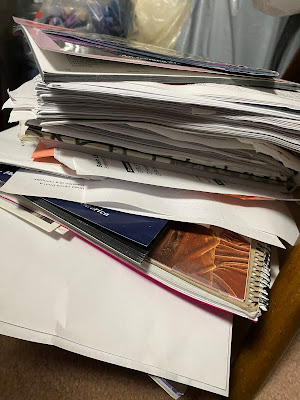 |
| Zip tie loop option for hanging |
Goal number two on my February
list was to enter my quilts in the Clark County Quilters show/
Quiltfest Northwest which will be held April 4-6, 2024. This year, the guild provided an online method to enter our quilts. While it has some issues for the entrant, I believe the online entry process will help organizers categorize the quilts and organize them much faster.
 |
| Close up of Fly Home |
I entered four quilts. My entries are:
42 Minis--display only as the past presidents of the guild are showing the quilts that they made with the blocks the members gave them at the end of their term.
Nuggets--an entry representing our Thread Tales group and the book "Where the Forest Meets the Stars."
Lone Star Modern Contemporary--entered in the pieced category. Lime Sprinkle--an entry representing the Lime Twist Challenge through the small group Mod Squad. I need to finish Lime Sprinkle. . .it isn't even a top. . .yet!!!!
In January, the Portland Modern Guild put out a call for entries to display quilts at the Vancouver Public Library. This is my second year as a member. I haven't made a project from a workshop or a challenge. . .but, using books as inspiration, I have created a few modern looking quilts. I thought what better place to display book inspired quilts than a library!
 |
| Close up of Circling the Sun |
I entered four quilts.
Crossroads (The Time Traveler's Wife),
Rue (The Hunger Games),
Fly Home (The All Girl Filling Station's Last Reunion) and
Circling the Sun (West with the Night.) A few days after I entered, I received notification that all FOUR of the quilts were accepted! I was excited!! I hope that I can see the quilts hanging at the library. I am humbled and honored to have been selected.
 |
| Close up of Crossroads |
To hang the quilts, we are to provide a wooden slat or dowel with a hole drilled at each end that fits the sleeve of our quilt. We were to insert a zip tie into the hole and create a loop. The loop will fit the hook in the
library's hanging system. We could have also used a wooden slat or dowel that a contains screw with an eye. I went with the zip tie option.I'm happy to share my work. Fifteen years ago, I wanted to stitch an award winning quilt. I thought I had stitched a winner. I showed it in a couple of smaller shows. I entered it in big shows; but, it was not selected to hang. The judge's comments were similar. There was one section of the quilt that drew criticism.
 |
| Close up of Rue |
It was then that I had a decision to make. Stitch quilts that the judges will like or stitch quilts the way I like. I stopped entering national shows. I share quilts at the county fair and at the guild shows.
I appreciate other artists and quilters when they share their work. Seeing my work hung creates a feeling of amazement within my soul. I've spent hours working closing on the project. When I view it hanging, I grin because the overall impact is what I haven't seen working so closely on it!
Putting my work in the public eye, also places me in a vulnerable position, Some attendees can be overheard saying the most unwelcome comments. I am choosing to be brave! The best quilt shows/displays are the ones that share quilts with a variety of techniques and made with various levels of difficulty. Goal number 14 on my February list was to write a post sharing the acceptance news.
In the header on my blog, I have tabs for completed quilts and books read. I have a tab labeled Thread Tales Quilts. This is where I've listed the books our group has read over the years. Corresponding to the book, I've noted a response. Often, there is a completed quilt listed with a link to read the story about the project.

















































